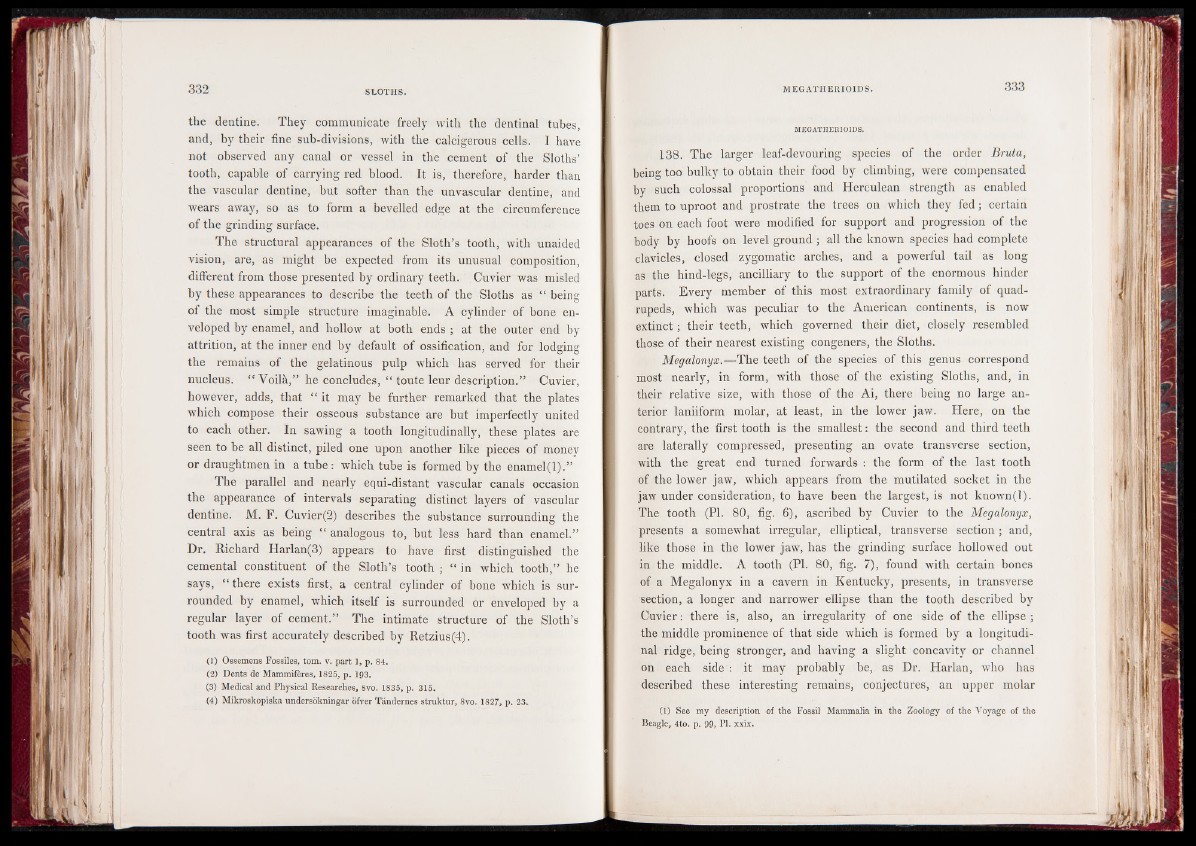
the dentine. They communicate freely with the dentinal tubes,
and, by their fine sub-divisions, with the calcigerous cells. I have
not observed any canal or vessel in the cement of the Sloths’
tooth, capable of carrying red blood. It is, therefore, harder than
the vascular dentine, but softer than the unvascular dentine, and
wears away, so as to form a bevelled edge at the circumference
of the grinding surface.
The structural appearances of the Sloth’s tooth, with unaided
vision, are, as might be expected from its unusual composition,
different from those presented by ordinary teeth. , Cuvier was misled
by these appearances to describe the teeth of the Sloths as “ being
of the most simple structure imaginable. A cylinder of hone enveloped
by enamel, and hollow at both ends ; at the outer end by
attrition, at the inner end by default of ossification, and for lodging
the remains of the gelatinous pulp which has served for their
nucleus. “ Voilà,” he concludes, “ toute leur description.” Cuvier,
however, adds, that “ it may be further remarked that the plates
which compose their osseous substance are hut imperfectly united
to each other. In sawing a tooth longitudinally, these plates are
seen to be all distinct, piled one upon another like pieces of money
or draughtmen in a tube : which tube is formed by the enamel(l).”
The parallel and nearly equi-distant vascular canals occasion
the appearance of intervals separating distinct layers of vascular
dentine. M. F. Cuvier(2) describes the substance surrounding the
central axis as being “ analogous to, but less hard than enamel.”
Dr. Richard Harlan(3) appears to have first distinguished the
cemental constituent of the Sloth’s tooth ; “ in which tooth,” he
says, “ there exists first, a central cylinder of bone which is surrounded
by enamel, which itself is surrounded or enveloped by a
regular layer of cement.” The intimate structure of the Sloth’s
tooth was first accurately described by Retzius(4).
(1) Ossemens Fossiles, tom. v. part 1, p. 84.
(2) Dents de Mammifères, 1825, p. 193.
(3) Medical and Physical Researches, 8vo. 1835, p. 315.
(4) Mikroskopiska undersokningar ôfver Tandernes struktur, 8vo. 1827, p. 23.
MEGATHERIOIDS.
138. The larger leaf-devouring species of the order Bruta,
being too bulky to obtain their food by climbing, were compensated
by such colossal proportions and Herculean strength as enabled
them to uproot and prostrate the trees on which they fed; certain
toes on each foot were modified for support and progression of the
body by hoofs on level ground ; all the known species had complete
clavicles, closed zygomatic arches, and a powerful tail as long
as the hind-legs, ancilliary to the support of the enormous hinder
parts. Every member of this most extraordinary family of quadrupeds,
which was peculiar to the American continents, is now
extinct; their teeth, which governed their diet, closely resembled
those of their nearest existing congeners, the Sloths.
Megalonyx.—The teeth of the species of this genus correspond
most nearly, in form, with those of the existing Sloths, and, in
their relative size, with those of the Ai, there being no large anterior
laniiform molar, at least, in the lower jaw. Here, on the
contrary, the first tooth is the smallest: the second and third teeth
are laterally compressed, presenting an ovate transverse section,
with the great end turned forwards : the form of the last tooth
of the lower jaw, which appears from the mutilated socket in the
jaw under consideration, to have been the largest, is not known(I).
The tooth (PL 80, fig. 6), ascribed by Cuvier to the Megalonyx,
presents a somewhat irregular, elliptical, transverse section; and,
like those in the lower jaw, has the grinding surface hollowed out
in the middle. A tooth (PI. 80, fig. 7), found with certain bones
of a Megalonyx in a cavern in Kentucky, presents, in transverse
section, a longer and narrower ellipse than the tooth described by
Cuvier: there is, also, an irregularity of one side of the ellipse ;
the middle prominence of that side which is formed by a longitudinal
ridge, being stronger, and having a slight concavity or channel
on each side : it may probably be, as Dr. Harlan, who has
described these interesting remains, conjectures, an upper molar
(1) See my description of the Fossil Mammalia in the Zoology of the Voyage of the
Beagle, 4to. p, 99, PI. xxix.